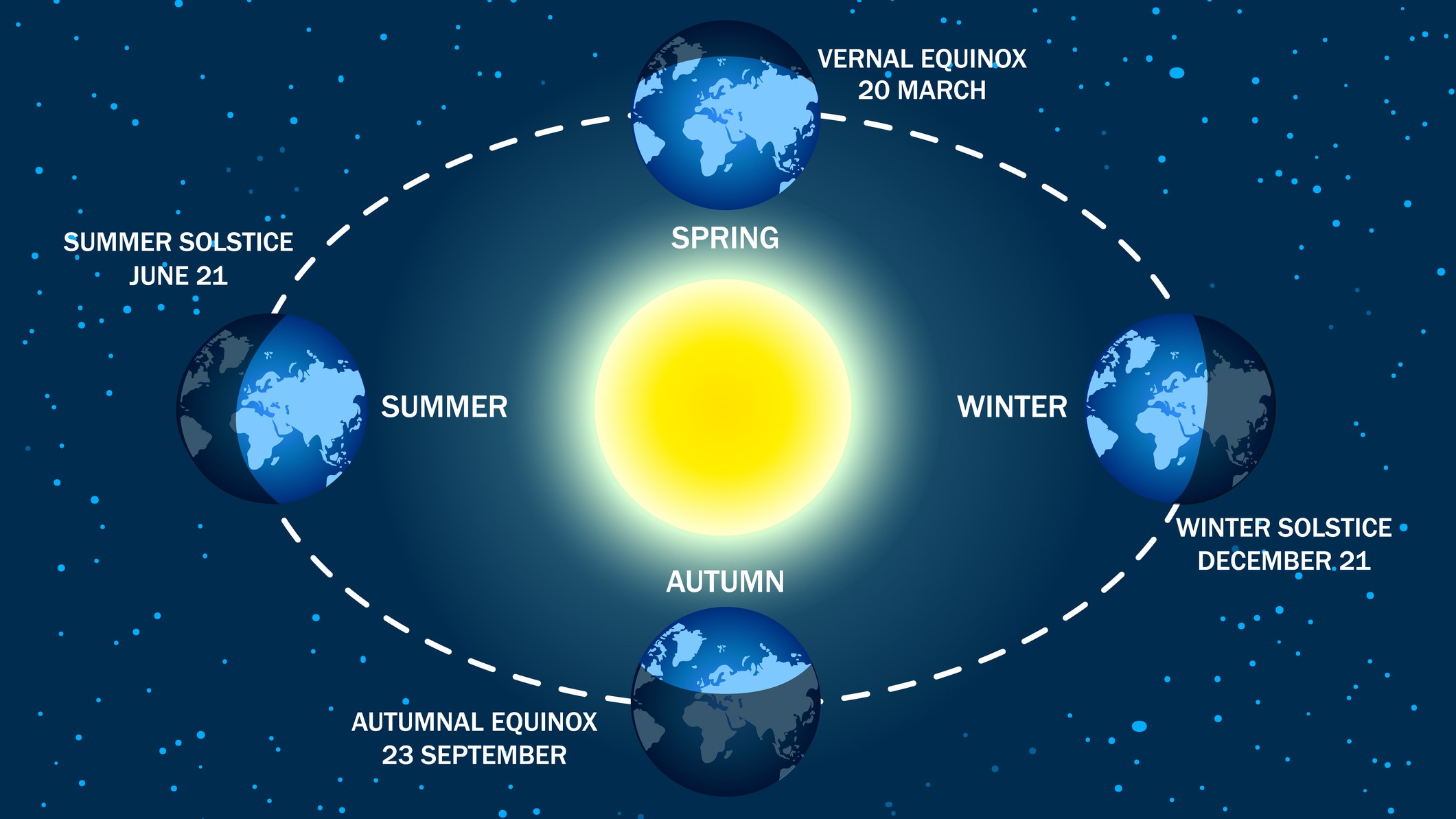The four seasons of the year: spring, summer, autumn (fall) and winter
The four seasons have very different characteristics.

Seasons are periods of the year with distinct weather conditions and day lengths.
The four seasons — winter, spring, summer, autumn — can vary significantly in characteristics and can prompt changes in the world around them. Here, we explore the seasons of the year in more detail.
Attributes of the seasons may vary by location, but there are still broad definitions that cross most of the boundaries.
Spring
In the spring, seeds take root and vegetation begins to grow. The weather is warmer and often wetter. Animals wake or return from warmer climates, often with newborns. Melting snow from the previous season, along with increased rainfall, can cause flooding along waterways, according to the Federal Emergency Management Agency (FEMA).
Summer
In the summer, temperatures may increase to the hottest of the year. If they spike too high, heat waves or droughts may cause trouble for people, animals, and plants. For example, in the summer of 2003, the high temperatures claimed more than 30,000 lives, according to Encyclopedia Britannica. Rainfall may increase in some areas, as well. Others may receive less water, and forest fires may become more frequent.
When does summer start?
In the Northern Hemisphere, summer starts on June 1 and runs to August 31
What is the hottest summer on record?
Historically, the heatwave during the Dust Bowl Summer of 1936 was considered the hottest summer on record, but in 2021 the average summer temperature of the contiguous U.S. was 74.0 degrees Fahrenheit (23.3 degrees Celsius), 2.6 degrees above average, according to the National Oceanic and Atmospheric Administration (NOAA).
Autumn (Fall)
In the autumn, or fall, temperatures cool again. Plants may begin to grow dormant. Animals might prepare themselves for the upcoming cold weather, storing food or traveling to warmer regions.
Various cultures have celebrated bountiful harvests with annual festivals. Thanksgiving is a good example. "Thanksgiving in the United States is a historical commemoration but it has a spiritual dimension strongly associated with homecoming and giving praise for what has been bestowed upon us," Cristina De Rossi, an anthropologist at Barnet and Southgate College in London, told Live Science.
Get the world’s most fascinating discoveries delivered straight to your inbox.
Why is it called autumn instead of fall?
Both 'autumn' and 'fall' are words used in the English language to describe the season that starts on 1 September in the Northern Hemisphere, with fall being commonly used in American English. According to Dictionary.com, the word autumn comes from the old French word 'autompne', which itself originated from the Latin 'autumnus'. The roots of the Latin name are obscure, but it was first recorded in the English language from the late 1300s.
Winter
Winter often brings a chill. Some areas may experience snow or ice, while others see only cold rain. Animals find ways to warm themselves and may have changed their appearance to adapt. "In a similar way to the Autumnal theme, Winter festivals celebrate the return of the light during a time of deepest physical darkness," said De Rossi. The Indian festival of Diwali, for example, which takes place between October and November, celebrates the triumph of righteousness, and light over darkness.
Is winter the longest season?
Although it is easy to imagine the seasons neatly fitting into four equal lengths, according to NPR this isn't quite the case, they are all slightly different — and their duration changes depending on which hemisphere you are in.
Due to the elliptical orbit of Earth around the sun, at certain points in the year the planet is moving faster and shortening the season. However, the distance from our star has less impact on Earth's seasons than the planet's tilt, which means that summers are warm in the Northern Hemisphere despite being further from the sun. As it is moving slower, the spring-summer season is also actually longer, by about seven days.
Seasons are not the same everywhere
The timing and characteristics of the seasons depend upon the location on Earth. Regions near the equator experience fairly constant temperatures throughout the year, with balmy winters barely discernible from warm summers. This is because it gets fairly constant light from the sun, due to its position on the outer curve of the Earth, according to the Atmospheric Radiation Measurement (ARM) program.
For areas to the north and south, the seasons can change more significantly. People closer to the poles might experience icier, more frigid winters, while those closer to the equator might suffer hotter summers.
According to Time and Date:
– Spring: March 1 to May 31;
– Summer: June 1 to August 31;
– Autumn (Fall): September 1 to November 30
– Winter: December 1 to February 28 (February 29 in a leap year).
Other factors can also affect the weather and temperature over the seasons; some areas experience dry summers as temperatures spike, while others might call summer their "wet season." A wet season is when a majority of a country or region's annual precipitation occurs, according to the Met Office. Mountainous regions might experience more snowfall than plains within the same latitude, while oceanfront property could see an increase in violent tropical storms as the weather shifts.
The time of year a region experiences a season depends on whether it is in the northern or southern hemisphere. The Southern Hemisphere experiences winter while its northern neighbors encounter summer; the north sees the slow blossom of spring while the south brings in the autumn harvest.
What causes the seasons?
The cycle of seasons is caused by our planet's tilt toward the sun. The Earth spins around an (invisible) axis. At different times during the year, the northern or southern axis is closer to the sun. During these times, the hemisphere tipped toward the star experiences summer, while the hemisphere tilted away from the sun experiences winter, according to NOAA.
At other locations in Earth's annual journey, the axis is not tilted toward or away from the sun. During these times of the year, the hemispheres experience spring and autumn.
The astronomical definition of the seasons relates to specific points in Earth's trip around the sun. The summer and winter solstice, the longest and shortest day of the year, occurs when Earth's axis is either closest or farthest from the sun. The summer solstice in the Northern Hemisphere occurs around June 21, the same day as the winter solstice in the Southern Hemisphere, according to NOAA. The south's summer solstice occurs around December 21, the winter solstice for the north. In both hemispheres, the summer solstice marks the first day of astronomical summer, while the winter solstice is considered the first day of astronomical winter.
Equinoxes are another significant day during Earth's journey around the sun. On these days, the planet's axis is pointed parallel to the sun, rather than toward or away from it. Day and night during the equinoxes are supposed to be close to equal. The spring, or vernal, equinox for the northern hemisphere takes place around March 20, the same day as the south's autumnal equinox. The vernal equinox in the southern hemisphere occurs around September 20, when people in the north celebrate the autumnal equinox. The vernal equinox marks the first day of astronomical spring for a hemisphere, while the autumnal equinox ushers in the first day of fall.
But changes in the weather often precede these significant points. The meteorological seasons focus on these changes, fitting the seasons to the three months that best usher them in. December to February marks meteorological winter in the Northern Hemisphere and meteorological summer in the southern. March, April, and May are lauded as spring or autumn, depending on the location, while June through August are the months of summer for the north and winter for the south. September, October, and November conclude the cycle, ushering in fall in northern regions and spring in southern, according to NOAA.
The seasons can bring a wide variety to the year for those locations that experience them in full. The weather in each one may allow people to engage in activities that they cannot perform in others — skiing in the winter, swimming in the summer. Each season brings with it its own potential dangers, but also its own particular brand of beauty.
Additional resources
Explore the seasons in more detail with this educational material from Lumen Learning. Earth is not the only planet with seasons, if you would like to learn more about seasons on other planets check out this article from NASA. Discover what causes the seasons with this informative piece from the National Weather Service.
Bibliography
- De Paor, Declan G., et al. "Exploring the reasons for the seasons using Google Earth, 3D models, and plots." International Journal of Digital Earth 10.6 (2017): 582-603.
- Khavrus, Vyacheslav, and Ihor Shelevytsky. "Geometry and the physics of seasons." Physics Education 47.6 (2012): 680.
- Yolen, Jane. Ring of Earth: A Child's Book of Seasons. StarWalk Kids Media, 2014.

Nola Taylor Tillman is a contributing writer for Live Science and Space.com. She loves all things space and astronomy-related, and enjoys the opportunity to learn more. She has a Bachelor’s degree in English and Astrophysics from Agnes Scott college and served as an intern at Sky & Telescope magazine. In her free time, she homeschools her four children.
- Alina BradfordLive Science Contributor
- Daisy DobrijevicReference Channel Editor, Space.com



